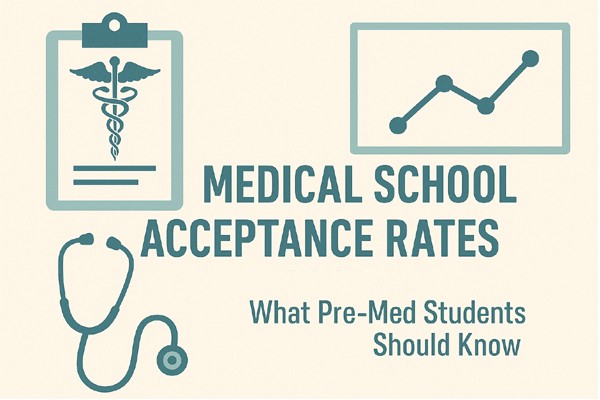Medical school acceptance rates are a key concern for every applicant. In this guide, we break down the latest acceptance rate stats, what influences them, and how you can use this info to build a smart application strategy. If you're working on your AMCAS application or need help with your medical school personal statement, this guide will help you plan your approach based on real data and trends.
>>Want us to help you get accepted? Schedule a free initial consultation here <<
What Is a Medical School Acceptance Rate?
- It’s the percentage of applicants offered admission in a given cycle.
- Calculated by dividing the number of accepted students by total applicants.
- Varies widely depending on school, applicant pool, and state residency.
Other stats:
- Average number of schools applied to: 18
- Fewer total applicants than in previous 7 years
- Top schools like Albert Einstein College of Medicine have rates as low as 1.85%
What Affects Medical School Acceptance Rates
- Number of applicants vs. seats available
- Public vs. private institutions
- In-state vs. out-of-state status
- GPA and MCAT scores
- Quality of extracurriculars
- Secondary essays and interview performance
- Changes in school policy and national trend
How to Use Acceptance Rate Data
- Build a balanced school list with reach, match, and safety options.
- Check median GPA and MCAT scores for each school.
- Don’t rule out "reach" schools if you have strong qualitative components.
- Apply early and complete secondaries ASAP.
What Acceptance Rates Don't Tell You
- They don’t account for how qualified the applicant pool was.
- They don’t reflect your individual competitiveness.
- They can fluctuate year-to-year.
- Some schools receive huge application volumes, skewing their rates lower
Case Examples
- Albert Einstein College of Medicine: ~1.85% acceptance rate
- State public schools: Sometimes <5% due to massive applicant volume
Looking Ahead: Trends in Acceptance
- Increased focus on holistic review
- Potential rebound in total applicants
- Growth in MD and DO program capacity
- More virtual interviews may influence yield rates
1. What is a good medical school acceptance rate?
Depends on context. Anything under 5% is very competitive. 10% or more is relatively more attainable.
2. Are DO acceptance rates better than MD?
They can be, but still competitive. Each program has its own focus and review method.
3. What’s more important—GPA or MCAT?
Both matter. A weaker GPA can sometimes be offset by a strong MCAT, and vice versa.
4. Will applying to more schools help?
Yes, but focus on quality. Don't send 30 apps without tailored secondaries.
5. Do acceptance rates favor in-state students?
At public schools, yes. Private schools are more flexible.
6. Are some schools just impossible to get into?
Not impossible, but highly selective. Look for mission-fit and align your app accordingly.
7. Should I worry about low acceptance rate schools?
No. Apply if you’re competitive. But balance your list with safer picks.
8. Can I improve my chances after applying?
Yes. Strong secondaries and interview performance can help you stand out.
To your success,
Your friends at BeMo

Like our blog? Write for us! >>
Have a question? Ask our admissions experts below and we'll answer!
Comments